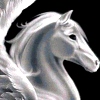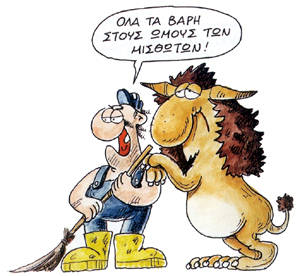
|
|





 |
|
||||||||
 |
 |
 |
 |
||||||

|
|||||||||
|
|
 1 Jan 2007, 02:35 PM 1 Jan 2007, 02:35 PM
Post
#1
|
|
 Lifetime commited Group: Elite Members Posts: 1981 Joined: 9-December 06 From: Σε δικο μου Σύμπαν Member No.: 3623 Zodiac Sign:  Gender:  |
[center]
 [/center] The Centaurs were half- horse creatures of ancient Greece and the spirits of the storm The Centaurs were the offspring of Ixion, the king of Lapithae (Thessaly), and the rain cloud Nephele. Their head, arms and torso had the human shape and their lower part was that of a horse. Their diet was adjusted according to their physical shape. The Centaurs were mainly living on the mount Pelion in Thessaly. With only few exceptions, such as Cheiron, the Centaurs were lawless, aggressive creatures and were usually drunk. The Centaurs were involved in a struggle with the Lapiths, known as "Centauromachy", when trying to intrude and cause trouble during the wedding feast of the Lapiths' King Peritheios with Ippodameia. The centauromachy caused the Centaurs' expelling from Thessaly. In early Attic vase-paintings, the head and torso of a human joined at the (human's) waist to the horse's withers, where the horse's neck would be. This half-human and half-animal composition has lead many writers to treat them as liminal beings, caught between the two natures, embodied in contrasted myths, of centaurs as the embodiment of untamed nature, as in their battle with the Lapiths, or conversely as teachers, as Chiron. Most are wild and savage, known for lustfulness and drunkeness. The exception is the wise Centaur Chiron. --------------------  |
|
|
 |
 3 Jan 2007, 06:34 PM 3 Jan 2007, 06:34 PM
Post
#2
|
|
 Lifetime commited Group: Elite Members Posts: 1981 Joined: 9-December 06 From: Σε δικο μου Σύμπαν Member No.: 3623 Zodiac Sign:  Gender:  |
Another group of Kentauroi made their home in the Peloponnese. THE KENTAUROI PELOPONNESIOI (or Peloponnesian Centaurs) were a group of Arkadian centaurs who battled Herakles for the wine of their brother Pholos. Most of them were slain in the conflict with his arrows. The few survivors fled to the Malean peninsular of southern Lakonia or Eleusis where they were given refuge by Poseidon.The Peloponnesian Kentauroi may have been a distinct breed from the Thessalian Kentauroi of Magnesia in northern Greece, although several classical authors do attempt to combine their stories
One author also mentions a tribe of bull-horned Cyprian Kentauroi. Female Kentaurides were also known, though they only seem to appear in late art and literature.THE KENTAURIDES (or Centaurides) were the female members of the Kentauroi (Centaur) tribe, creatures with the two-formed bodies of horses and men. Female Kentauroi are seldom mentioned in ancient literature, although they do occasionally appear in ancient Greek paintings and Roman era mosaics and reliefs. One Roman relief, housed in the Louvre Museum, shows a Kentauris with her horse-legged infant in the train of the god Dionysos.The Kentauroi were depicted with the upper bodies of men, from head to loins, set upon the body of a horse. Sometimes they were shown with the facial features of normal men, at other times they were portrayed with the snub noses and pointed ears of the rustic Satyroi. --------------------  |
|
|
 Eua1 Centaurs 1 Jan 2007, 02:35 PM
Eua1 Centaurs 1 Jan 2007, 02:35 PM
 Eua1 [center][/center]
Cheiron was the most famous Cen... 2 Jan 2007, 05:13 PM
Eua1 [center][/center]
Cheiron was the most famous Cen... 2 Jan 2007, 05:13 PM
 XRUSA Great story 3 Jan 2007, 03:23 PM
XRUSA Great story 3 Jan 2007, 03:23 PM
 Eua1 Thank you Nick for adding images in my posts
I r... 3 Jan 2007, 06:29 PM
Eua1 Thank you Nick for adding images in my posts
I r... 3 Jan 2007, 06:29 PM
 Eua1 Eurytion or Eurytus was one of the Centaurs involv... 4 Jan 2007, 05:07 PM
Eua1 Eurytion or Eurytus was one of the Centaurs involv... 4 Jan 2007, 05:07 PM
 Spartacus nice:) 4 Jan 2007, 05:08 PM
Spartacus nice:) 4 Jan 2007, 05:08 PM
 Eua1 A Centaur Nessus was one of the Centaurs who foug... 5 Jan 2007, 05:00 PM
Eua1 A Centaur Nessus was one of the Centaurs who foug... 5 Jan 2007, 05:00 PM
 Eua1 Pholus was one of the few Centaurs, who was friend... 26 Jan 2007, 04:22 PM
Eua1 Pholus was one of the few Centaurs, who was friend... 26 Jan 2007, 04:22 PM  |

|
Lo-Fi Version | Time is now: 8th July 2025 - 06:03 AM |
| Skin and Graphics by Dan Ellis and Anubis. Hosting by Forums & More © 2005-2011. |